Le Cinque Terre & La Spezia
a wonderful place.
Every year thousands of tourists from every corner of the planet decide to visit our territory. In the world if someone thinks about Liguria, or Italy, suddenly associate that thought with the image of the Cinque Terre, those five colored villages overlooking the sea, with their hills chiselled by vineyards.
Obviusly, as soon as someone thinks about La Spezia, the association is even more immediate! Thinking immediately of the Cinque Terre is common.
But our territory is not just Cinque Terre: The Gulf that hosts La Spezia, is not called "The Gulf of Poets" by chance, the extraordinary beauty of Portovenere and Lerici inspired poets and writers of world renown, just to name a few, Byron and Shelley. The whole coast is embellished by small seaside villages, pearls on the sea.
The hinterland is not far behind; the Val di Vara, with its villages full of historical and artistic importance, and the Val di Magra, which hosts a unique ecosystem, so unique that as to be protected by the homonymous Natural Park.
There is still so much to see!
For this reason we have prepared small information sections on the locations that you can reach in a few minutes from our hostel.Navigate using the hashtags!
Portovenere
The village is located at the southern end of a peninsula that forms the western shore of the Gulf of La Spezia or also known as the Gulf of Poets.
Although the oldest origins of the village date back to the 6th century BC up to the presence of the Ligurian peoples, the first historical date of Porto Venere dates back to Claudius Ptolemy (150 AD).
The name of the village (Portus Veneris) derives from a temple dedicated to the goddess Venus Ericina, located exactly where the church of San Pietro now stands. The name was probably linked to the fact that, according to tradition, the goddess was born from the foam of the sea, abundant just below the cliff.
From a fishing village, Porto Venere became a naval base of the Byzantine fleet, but was attacked and destroyed by Rothari, the king of the Lombards, in 643 AD.
The few Roman ruins, consisting of some walls found under the Spallanzani square, refer to the monastic Christian period of the monks of San Colombano, with the ancient church of San Pietro in the diocese of Luni. Between the eighth and the eleventh century it was the object of repeated attacks by the Saracens and the Normans.
In 1113, under the control of Genoa, Porto Venere had a quadrangular castle on the southern tip of the Arpaia promontory, next to the original church of San Pietro; in the same period the church of San Lorenzo and the new village were built.
Still under the dominion of Genoa the following fortifications were built in the territory of Porto Venere: the fortification of San Francesco and the fort of Sant'Ambrogio and, near the Palmaria, the fortress of Torre Scola in 1606.
With the French domination of Napoleon Bonaparte was annexed to the First French Empire (1798), then in 1815 it was incorporated into the Kingdom of Sardinia and later into the Kingdom of Italy (1861).
A famous holiday resort between the late 19th and early 20th centuries - among its most famous visitors was Lord George Gordon Byron - it is still a prestigious tourist destination.
Since 1997, Portovenere, together with the islands of Palmaria, Tino, Tinetto and the Cinque Terre has been included in the UNESCO world heritage list.
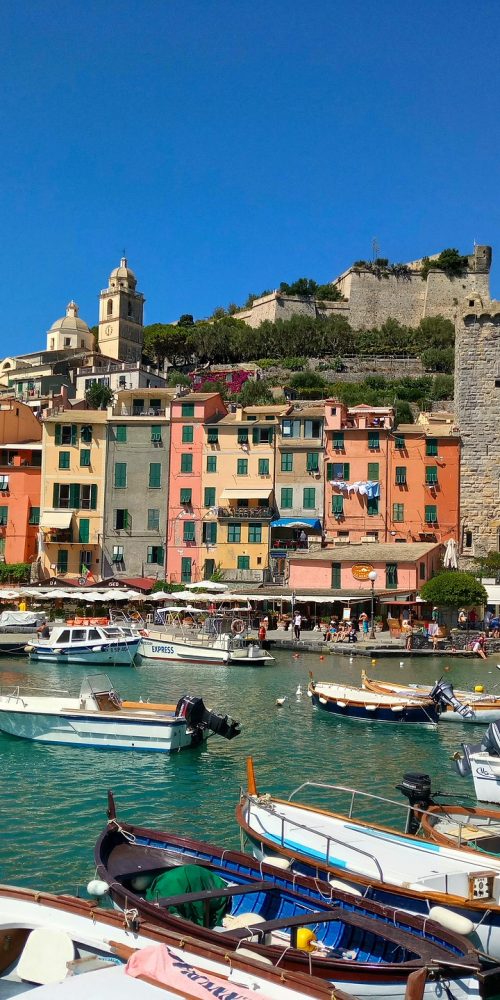
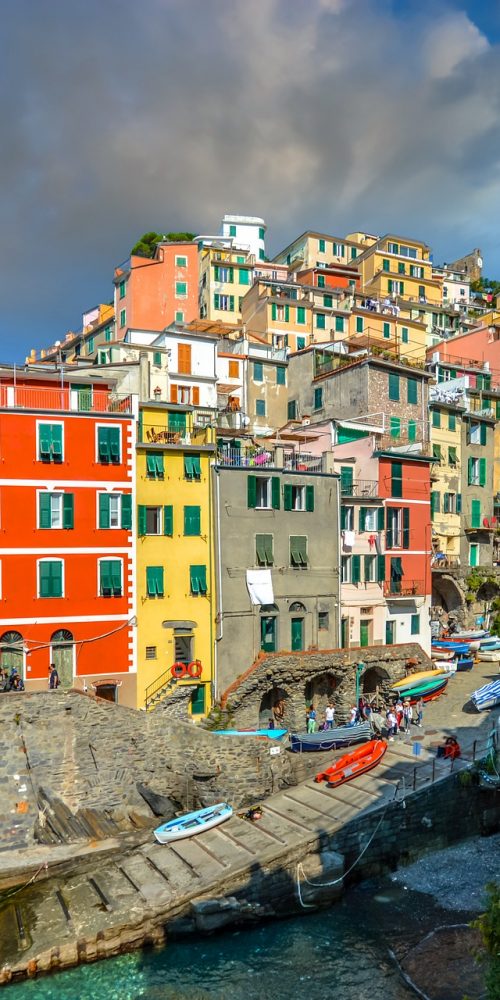
Riomaggiore
In Riomaggiore all the houses have two entrances: one on the front at the level of the alley, the other on the back, at the level of the upper road, so that in the 16th century the people had guaranteed an escape route in case of an attack by the Saracens.
The first news on the territory of Riomaggiore dates back to 1239, when the people of the Carpena district swore loyalty to the Company of Genoa, and when in 1251 the people of small villages halfway decided to meet at the mouth of the "river" and found Riomaggiore
In the nineteenth century he so enchanted the Florentine painter Telemaco Signorini, first exponent of the current of the macchiaioli, who painted the dark corners of the streets and the shadows of the stairs.
The marina is surrounded by medieval houses, based on the stone arches of the old wine warehouses, which go up the slope to the castle, which dominates the city. From there all the underwater excursions depart, in the clear waters of the Marine Reserve.
The Mariano di Montenero sanctuary is truly extraordinary, easily reachable from Riomaggiore through numerous paths. It is an extraordinary observation point: on a clear day, on the horizon, the Tuscan islands and Corsica seem to emerge from the sea.
From Riomaggiore to Manarola runs the Via dell'Amore (currently closed for renovation), romantic walk engraved and carved into the rock, overlooking the sea: a natural window to enjoy unforgettable sunsets and starry skies.
Manarola
Manarola was created by displaced people who from the Val di Vara and the Roman village of Volastra whom probably head towards the sea to exploit its resources.
A privileged position to admire the magnificent structure of the village is Punta Bonfiglio from where a walkway begins; the route was built by the people of Manarola and was opened in 1968, and connects the Marina with the port of Palaedo. On the top of Punta Bonfiglio we find the small cemetery of the village.
Not to be missed: since 1961, at Christmas time, on the hill overlooking the village is a picturesque light nativity scene (the largest in the world), whose characters, handmade by Mario Andreoli, are made up of thousands and thousands of lights installed on special models that give a unique charm to the representation.

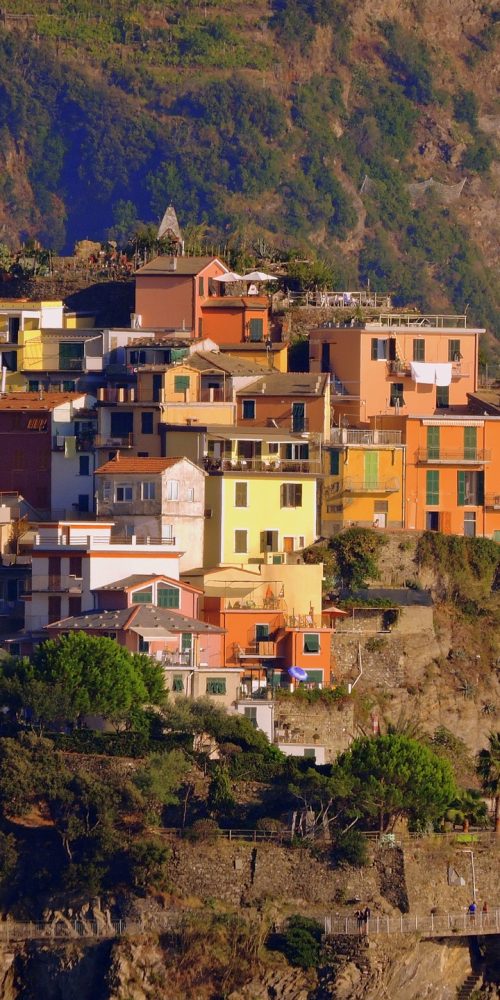
Corniglia
It differs from the other villages of the Cinque Terre as it is the only village that does not face directly on the sea, but is located at the top of a hill about three hundred feet high, surrounded by vineyards on the characteristic terraces.
The origins of the village date back to Roman times, the name probably derives from Gens Cornelia, the family owned the land. It is interesting to note that during the excavations of Pompeii wine amphorae were found on which the name "Cornelia" appeared.
Corniglia was under the dominion of the Republic of Genoa. In the 13th century the town had a castle, after the Genoese built a fortress to defend themselves from the frequent attacks of the pirates, whose traces can still be found on top of the promontory.
Among the main monuments that count, there is the parish church of San Pietro, a brilliant example of Ligurian Gothic monument of the fourteenth century.
On June 29th we celebrate the patron saint, St. Peter's; the celebration includes the traditional procession through the streets of the village, from the church of San Pietro to the terrace of Santa Maria.
The possibility to reach easily by train and the passage of the path n. 2 CAI (blue path) connecting Riomaggiore to Monterosso make it an ideal destination for those who want to admire the beauty of this magnificent stretch of the Ligurian coast.
Vernazza
The territory is part of the Cinque Terre National Park.
The first documentation concerning Vernazza dates back to an act of 1080 where the Castrum Vernatio is cited as the maritime base of the Obertenghi, were the lords of Vernazza in the eleventh and twelfth centuries and probably used the natural harbor as a starting point for ships defending attacks by Saracen pirates and for the first trade. Thanks to the increase in trade and the development of the navy, it was soon annexed to the Republic of Genoa.
With the new French domination of Napoleon Bonaparte, from 1797 Vernazza became part of the Ligurian Republic annexed to the First French Empire. In 1815 it was incorporated into the Kingdom of Sardinia, as established by the Congress of Vienna in 1814 for the other cities of the Ligurian Republic and later in the Kingdom of Italy.
The construction of the Vernazza and Cinque Terre railway network between the second half and the end of the 19th century will put an end to geographical and historical isolation. Then began a migration, at the beginning of the twentieth century, in the nearby cities and in the capital of La Spezia, especially for the excellent professional opportunities created by the construction of the military arsenal.
Today Vernazza is a destination for tourists who love to visit its architectural, artistic, historical beauties and for the dense network of hiking trails, which allow the connection between the five cities of the Cinque Terre and the connection between the coast with the center and the lower Val di Vara (including Corvara).
We suggest you to see the Church of Santa Margherita di Antiochia: the beautiful church that seems to emerge from the sea like a ship. According to some scholars, the building seems to date back to the first decades of the thirteenth century, while for others until the early decades of the twelfth century. The castle of the Doria that stands on top of the hill overlooking the city and the bay and oversees a wide stretch of open sea, the Belforte, the walls and the convent. And there is more that deserves to be included in the visit of one of the most picturesque villages of the Cinque Terre.
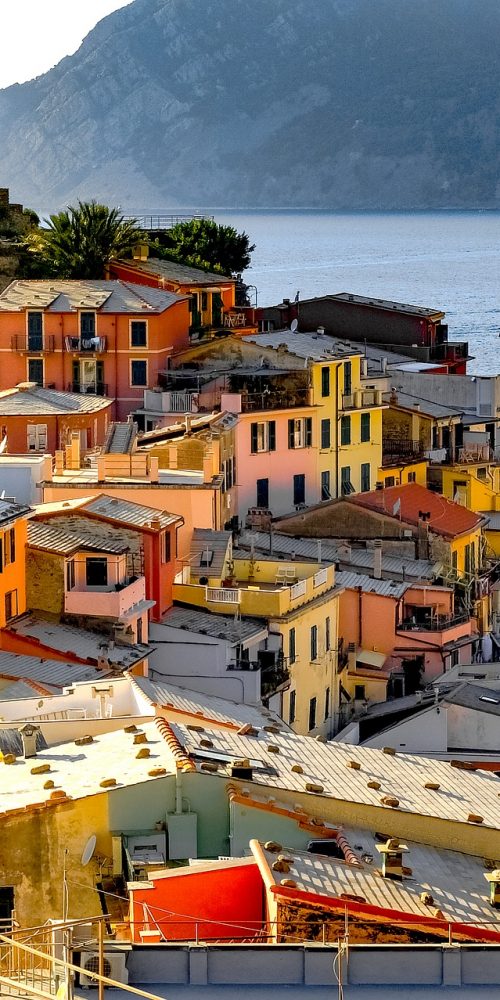
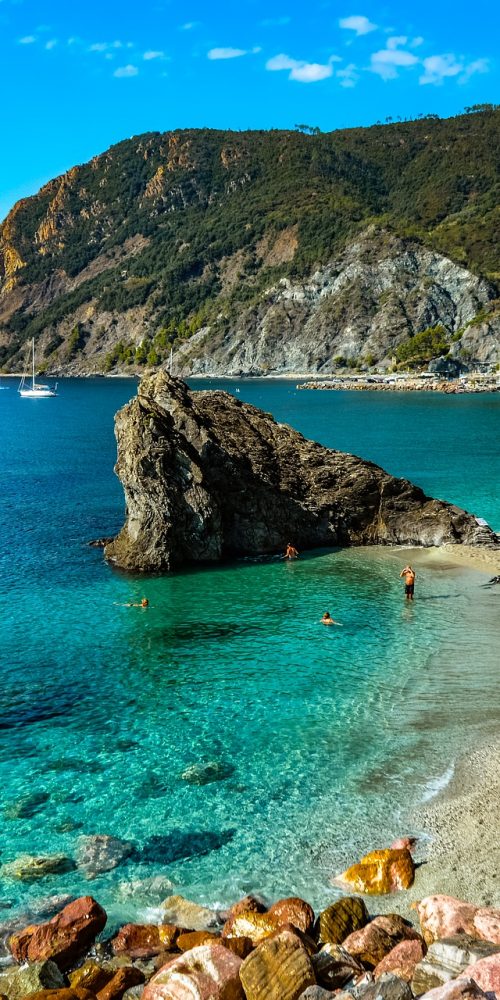
Monterosso
The village of Monterosso was probably founded by the survivors of Albareto, on the heights, destroyed by the Lombards (7th century). The settlement of the village took place at the mouth of the Torrente Buranco around the 9th century.
In the following centuries, because of the Saracen raids, sighting towers were built to sight the pirates. The first document referring to Monterosso dates back to 1056 under the Obertenghi domain; in the following centuries Monterosso and the Cinque Terre are a land of contention between Genoa and Pisa.
In the XII century the agricultural development of Monterosso began: along the coastal strip, cultivated strips were built, protected downstream from the dry stone walls for the cultivation of the vineyard. The economy of the village was based on fishing and the cultivation of lemons and vines.
Since the early 60s, the village has assumed a strong tourist vocation thanks to the beaches, crystal clear waters, the mild climate that together with an enchanting landscape have always been a destination for Italian and foreign tourism. Today there are hotels, restaurants, bars, bathing establishments and many other services that make Monterosso the capital of the Cinque Terre in the old fishing village and on the Lungomare di Fegina.
Among the things to see: the Parish Church of San Giovanni Battista (1244 - 1307) with the bell tower that was originally a watchtower, the Capuchin convent (seventeenth century) where, inside the church, you can admire a painting attributed to the Van Dick; The Aurora Tower (XVI century); The Sanctuary of N.S. di Soviore (VII-XIII century) located above Monterosso at 464 m.s.l. that legend has destroyed by the Lombards (7th century) with a miraculous finding of the effigy of the Madonna; the house that hosted the poet Eugenio Montale and the places that inspired some of his most famous works.
The village is surrounded by a dense hiking network: Monterosso - Vernazza pedestrian path; Path Monterosso - Sanctuary of San Antonio in Mesco (ruins, XIV century); ancient road Monterosso - Sanctuary of N.S. of Soviore; stairway to the Capuchin Convent and the ancient walls of the castle, now a municipal cemetery.
It is also possible by train or boat to visit the other villages of the Cinque Terre.
Corvara
Corvara is an ancient village surrounded by the peaks of the Ligurian Apennines, behind the Cinque Terre, located in the middle and lower Val di Vara, in the province of La Spezia.
The first citations date back to the beginning of the year 1000 D.C. when it became one of the most important Podesterias of the district of Eastern Liguria in the sec. XII up to 1500.
The castle of Corvara was of considerable importance thanks to the strategic position it occupied: stronghold first of the Estensi and then of the Marquises Malaspina, adventurously passed to the Fieschi, the castle was mentioned in 1273, during the expedition of Oberto Doria against La Spezia.
Nowadays, of the important medieval center, there are two strong towers, which had to form a defensive block with the walls, and a wall, the only remaining part of the castle, overlooking the town. Here and there ancient inscriptions and bas-reliefs still testify to the glorious past of Corvara.
It is also worth visiting the church of S. Michele Arcangelo, dating back to 1300: on the bell tower, which once served as a defensive tower, there is an animal head.
Returning to the present Corvara remains a harmonious environment that has been able to combine the glories of the past with the needs of today. A relaxing environment where you can enjoy the greenery and silence a stone's throw from the sea of the Cinque Terre.
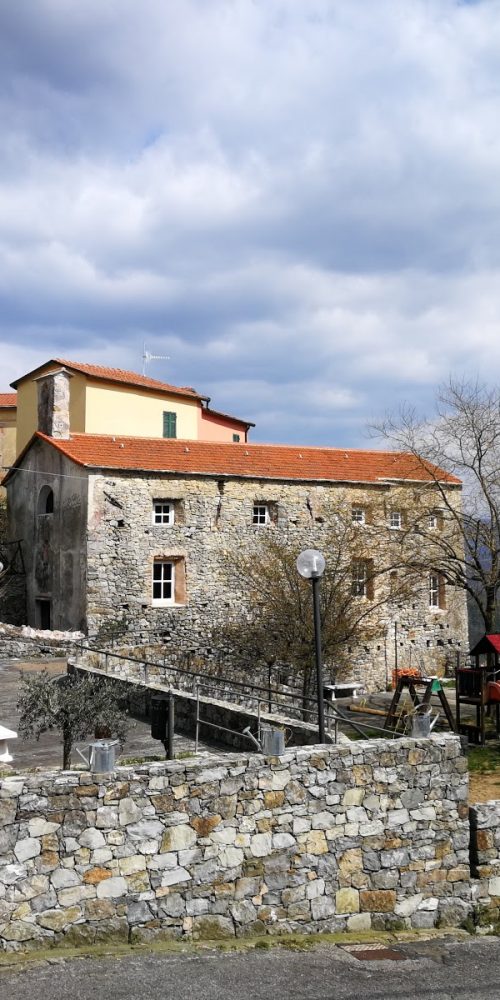
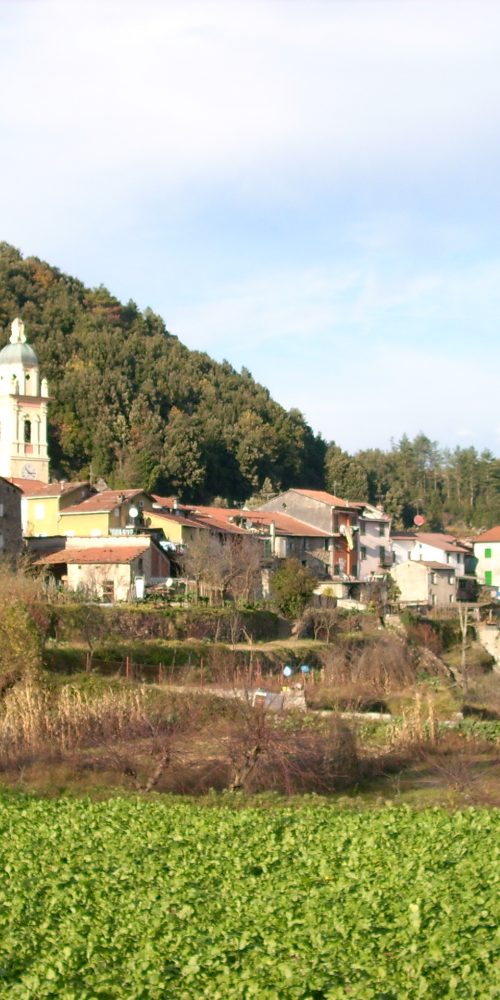
Pignone
Pignone is an Italian town of 600 inhabitants in the province of La Spezia, 10 minutes from Corvara, on the provincial road that leads to Monterosso, the largest village in the Cinque Terre.
Since 2009, the municipality has been awarded the Orange Flag by the Italian Touring Club.
In a letter of Pope Eugenius III - dated 1149- it is widely described the housing settlement that may have already been present in Roman times as a Roman pagus (rural territorial district centered on local pagan places first and then Christian).
According to some studies, the village was very important for the Roman Empire because it is located at the crossroads of two important roads of communication, one for the ancient Segesta Tigullorum (today's Sestri Levante) and the other towards Velleia important center of the appennino piacentino.
The origin of the village could be traced much earlier than the Roman era because in a hill called "Castellaro" have been found archaeological sites dating back to the Bronze Age and Iron and traces of an ancient population of the Ligurian family. Today, the area, whose findings are on display at the "Ubaldo Formentini" archaeological museum in La Spezia, has been included since 2000 among the environmental protection sites as a site of community interest.
From 1163 the territory was subjected, at the behest of the emperor Federico Barbarossa, to the Malaspina family and subsequently to the Counts-bishops of Luni.
It was the same bishop of Luni, Guglielmo, who ceded the feud from 1252 to the Fieschi family, the noble family of Lavagna. They rebuilt the parish church and improved the road system to allow a rapid road connection with the centers of Levanto and Sarzana. In 1276 the property on the feud was sold to the Republic of Genoa, which therefore followed the fate and the glories.
During the sixteenth century the primitive medieval village of Pignone experienced a substantial evolutionary phase of architecture and urbanism with the construction of new mansions and the modification of access to the historic village with the opening of three new controlled and defended passages.
With the new French domination of Napoleon Bonaparte the whole territory returned from 1797 within the Ligurian Republic annexed to the First French Empire.
In 1815 it was incorporated into the Kingdom of Sardinia and subsequently into the Kingdom of Italy from 1861.
The parish church of S. Maria Assunta deserves to be visited, dating back to a thousand, with subsequent reconstruction of the 1300s and 1700s.
The karst caves and the sinkhole of S. Antonino are of striking beauty: on the road that leads from Pignone to Casale it is possible to admire the most complex cave system in the province of La Spezia; about twenty meters deep.
Recall in the month of September the "Gli Orti di Pignone" market exhibition is the most important initiative during the year with the great participation of voluntary organizations and groups and numerous exhibitors. In the numerous stands it is possible to taste typical local products.

